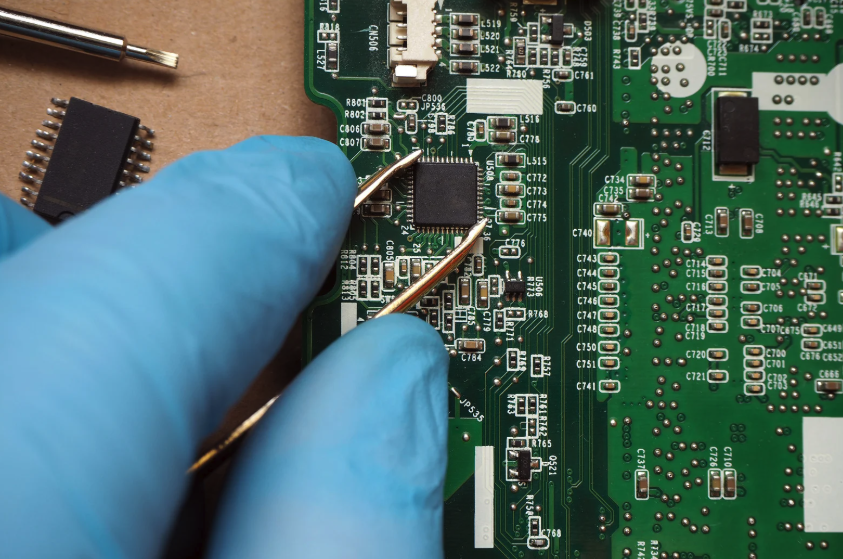Semiconductors and Consumer Electronics

More from the Category
Semiconductors are the foundation of modern consumer electronics. From the smartphone in your pocket to the smart TV in your living room, these tiny components form the backbone of nearly every device that powers today’s connected world. They enable the processing, storage, and communication functions that define our digital era.
The evolution of semiconductor technology has directly shaped the consumer electronics landscape. Advances in materials and design have made devices faster, smaller, and more efficient while accommodating increasing user demands. Whether through AI-enabled gadgets, 5G-enabled smartphones, or energy-efficient appliances, semiconductors are at the heart of innovation.
In this article, we’ll explore the intricate relationship between semiconductors and consumer electronics. We’ll look at the technologies driving this partnership, the market trends shaping the industry, and the future of semiconductors. For professionals in the electronic components field, understanding these dynamics isn’t just an academic exercise — it’s how you stay competitive in a rapidly evolving market.
The Role of Semiconductors in Consumer Electronics
Semiconductors are the core components that enable the functionality of modern consumer electronics. These versatile materials power devices by controlling electrical signals and act as the foundation for processors, memory, sensors, and communication systems. Their role is crucial in making today’s gadgets smarter, faster, and more efficient.
Essential Components in Modern Devices

At the heart of every smartphone, laptop, and gaming console lies a semiconductor. Key components used in consumer electronics — like microprocessors, GPUs, and SoCs — rely on semiconductors to perform computation, data processing, and graphics rendering. Memory chips, such as DRAM and NAND flash, store and retrieve data seamlessly to deliver the instant responsiveness we expect from our
Advanced semiconductor technologies allow smartphones to handle tasks like real-time photo editing, AI-driven personal assistants, and high-speed internet connectivity — innovations that aren’t possible without the precise engineering of semiconductor materials.
Enabling Connectivity and Intelligence
The integration of semiconductors into wireless technologies has revolutionized consumer electronics. Semiconductors in modems and transceivers allow devices to connect and communicate seamlessly, and IoT-enabled gadgets, from smart thermostats to fitness trackers, depend on these chips to provide real-time data and automation. Semiconductors also power sensors in devices that enable facial recognition, fingerprint scanning, and augmented reality.
Balancing Performance and Efficiency
One of the most remarkable achievements of modern semiconductors is improving raw performance with energy efficiency. Laptops and gaming consoles require powerful processing units, but they also need to manage heat and power consumption. Advanced manufacturing processes have enabled chipmakers to pack billions of transistors onto a single die, which not only boosts performance but also reduces energy usage.
The continuous improvement of semiconductors ensures that consumer electronics evolve to meet rising user expectations. From high-resolution displays to immersive audio experiences, these components underpin many cutting-edge features.
Key Innovations Shaping Consumer Electronics

Semiconductor innovation is driving the rapid advancements in consumer electronics. As demands for smarter, faster, and more energy-efficient devices grow, breakthroughs in semiconductor design and manufacturing are having transformative effects.
Miniaturization: Smaller Yet Mightier
The ongoing drive to shrink transistors has enabled the creation of more compact, powerful devices. Modern processors are manufactured using advanced lithography techniques, such as extreme ultraviolet (EUV), which allow for nodes as small as 3nm. This miniaturization results in increased performance and reduced power consumption.
Smaller chips have enabled wearable technologies like fitness trackers and smartwatches, and the trend toward lighter and thinner smartphones, laptops, and tablets has been made possible by this relentless pursuit of miniaturization.
Emerging Materials: Beyond Silicon
While silicon remains dominant, materials like gallium nitride (GaN) and silicon carbide (SiC) are gaining traction because they offer superior efficiency, particularly in high-power and high-frequency applications — which makes them ideal for fast chargers, 5G base stations, and electric vehicles.
GaN, for example, allows for smaller and more efficient power adapters, and as industries push the boundaries of device capabilities, such advanced materials are becoming indispensable.
System-on-Chip (SoC) Integration
The rise of System-on-Chip (SoC) designs has transformed device architecture. By integrating multiple functions — such as processing, graphics, and connectivity — onto a single chip, SoCs reduce size and improve performance.
This innovation has been crucial in devices like smartphones and gaming consoles, where space is limited, and performance demands are high. For example, Apple’s M-series chips combine CPU, GPU, and neural engines to deliver unparalleled efficiency and power.
Advancements in AI Processing
AI-driven features in consumer electronics, from voice assistants to smart cameras, require chips with specialized AI capabilities. Semiconductor manufacturers are developing AI accelerators, which optimize tasks like natural language processing and image recognition.
Google’s Tensor Processing Units (TPUs) and Apple’s Neural Engine exemplify how dedicated AI hardware is improving device intelligence and efficiency. These innovations are key to the seamless operation of AI-enabled consumer gadgets.
Flexible and Organic Semiconductors
Flexible and organic semiconductors are unlocking new possibilities for consumer electronics, particularly in wearables and displays. These materials enable foldable screens, curved displays, and lightweight, flexible devices. Foldable smartphones and rollable OLED TVs showcase the potential of these technologies and offer consumers novel ways to interact with their devices. Organic semiconductors are also being explored for applications in energy-efficient, printable electronics.
Quantum and Photonic Chips
Although still in nascent stages, quantum and photonic chips represent the next frontier for consumer electronics. Quantum chips promise unparalleled processing power for complex tasks, while photonic chips enable high-speed communication with reduced energy consumption.
These technologies are expected to impact high-performance consumer applications like AR/VR systems and real-time language translation.
Market Trends in Semiconductor Applications
The semiconductor industry is rapidly evolving to support diverse applications, with several key trends shaping its growth:
AI and Machine Learning Integration
Artificial intelligence (AI) and machine learning are driving significant demand for advanced semiconductors, particularly in data centers and edge computing devices. Chips designed for AI applications, such as GPUs and neural processing units (NPUs), are essential for enabling real-time data analysis and machine learning algorithms.
Automotive Industry Expansion
The push toward electric vehicles (EVs) and autonomous driving technologies has transformed the automotive sector into a major consumer of semiconductors. Advanced driver-assistance systems (ADAS), battery management, and vehicle connectivity require increasingly sophisticated chips, which has fueled the growth of power semiconductors and sensors.
5G Connectivity
The global rollout of 5G networks is another significant driver of the semiconductor industry. 5G demands advanced semiconductor solutions with high-speed, low-latency capabilities for smartphones, infrastructure equipment, and IoT devices.
Sustainability and Energy Efficiency
Sustainability is influencing design priorities, with a focus on energy-efficient semiconductors for both industrial and consumer applications. And innovations in gallium nitride (GaN) and silicon carbide (SiC) are becoming more prominent in power management solutions for renewable energy systems and EV chargers.
Global Supply Chain Adjustments
Geopolitical factors and pandemic-related disruptions have emphasized the need for resilient supply chains. Many companies are localizing production and investing in domestic semiconductor fabs to mitigate those risks and meet demand surges, particularly in the U.S. and Europe.
These trends reflect how semiconductors have become indispensable across industries.
The Future of Semiconductors in Consumer Electronics
The evolution of semiconductors promises to redefine the landscape of consumer electronics and shape how devices are designed, manufactured, and used. Emerging technologies and market demands will guide this transformation and foster countless innovations.
Advanced Manufacturing Techniques
The transition to smaller process nodes, such as 3nm and beyond, is paving the way for higher transistor densities and improved energy efficiency. These advancements enable more powerful yet compact devices, ranging from ultra-thin laptops to augmented reality wearables.
Chiplet architectures, which integrate multiple functional blocks into a single package, are also gaining traction. This modular approach enhances flexibility and scalability, while reducing costs and delivering exceptional performance for gaming and AI-driven consumer electronics.
AI-Powered Devices
Semiconductors will continue to fuel the expansion of artificial intelligence in consumer electronics. Future devices will leverage AI processors for increasingly sophisticated tasks, from real-time language translation to hyper-personalized user experiences. AI-driven chips will also improve device energy efficiency by dynamically optimizing processes.
Integration of Photonics and Quantum Computing
Although still in development, photonic and quantum semiconductors are expected to revolutionize data processing and connectivity. Photonic chips, which use light for communication, can significantly enhance speed and energy efficiency in consumer devices. Quantum processors, while primarily focused on industrial applications, hold potential for future consumer applications in advanced encryption and ultra-fast computation.
Green Semiconductors
Sustainability is a growing focus for the semiconductor industry. Manufacturers are exploring eco-friendly materials and energy-efficient designs to minimize the environmental impact of electronics. Recycling initiatives and innovations like biodegradable semiconductors could redefine how devices are produced and disposed of as well.
The Rise of Flexible and Wearable Electronics
Flexible semiconductors are enabling a new wave of consumer electronics with adaptable form factors. Foldable smartphones, bendable displays, and wearable devices like smart fabrics will become mainstream as these technologies mature. These innovations not only enhance portability but also open up new applications in health monitoring, fitness, and AR/VR.
Customization and Edge Computing
Edge computing, where data processing occurs closer to the source rather than in centralized data centers, will drive the development of specialized semiconductors. As a result, consumer electronics will benefit from those developments in faster data processing, improved security, and reduced latency. Tailored chips designed for specific tasks will allow manufacturers to differentiate their products and cater to niche markets effectively.
Looking Ahead
The future of semiconductors in consumer electronics is marked by an increasing overlap between digital innovation and human-centric design. From enabling smarter, greener devices to supporting groundbreaking technologies like quantum computing and AR, semiconductors will remain the cornerstone of progress.
For the consumer electronics industry, the challenge lies not just in keeping pace with advancements but also in ensuring accessibility, affordability, and sustainability for a tech-savvy global audience.
And if you’re developing a new consumer electronic device, Microchip USA has the components you need to make your designs a reality. Whether you need SoCs, switches, power supplies, or resistors, we supply them all — and we pride ourselves on sourcing hard-to-find parts. Contact us today!